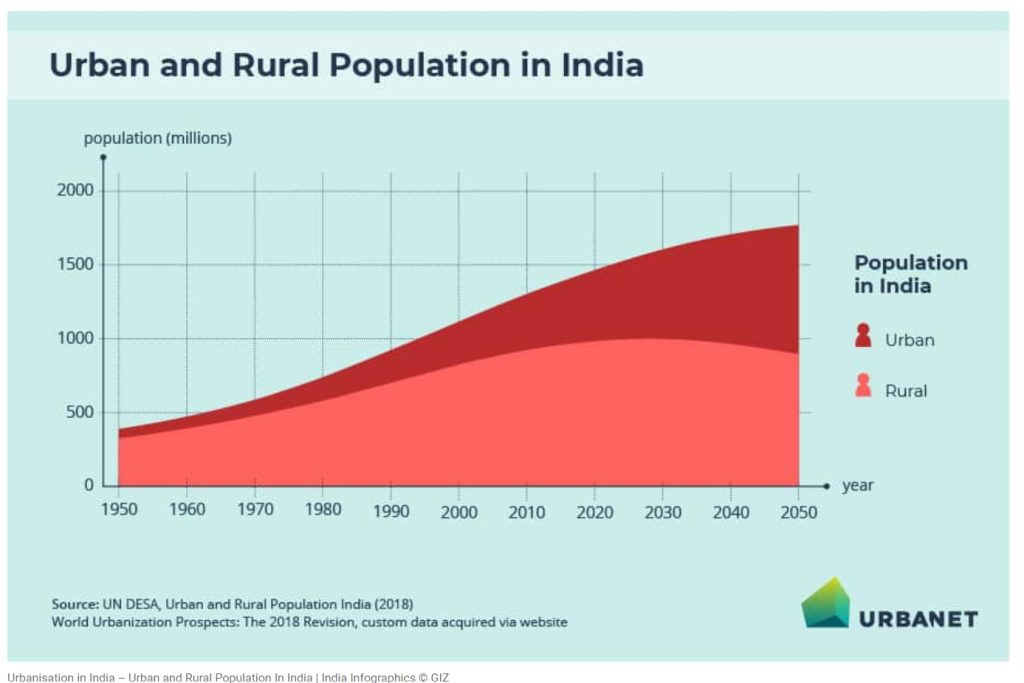CONTENTS
- An Outlining of Urban Transformation Strategies
- Is immunity for the President and Governors Absolute?
An Outlining of Urban Transformation Strategies
Context:
Around 50 crore people, making up about 36% of India’s population, live in cities. The urban population has been steadily increasing by 2% to 2.5% annually. This rapid urbanization in India necessitates ongoing investments with clear vision and commitment. The new government’s first budget recognizes cities as growth hubs and provides various options and opportunities for their planned development and growth.
Relevance:
GS1-
- Urbanization
- Population and Associated Issues
- Poverty and Developmental Issues
Mains Question:
State governments, their municipalities and also citizens will have to take forward the provisions outlined in the recent Budget to ensure planned urban development and growth. Discuss. (15 Marks, 250 Words).

Housing Issues:
- Since 2015, the Pradhan Mantri Awas Yojana (Urban) has been implemented to provide housing for the Economically Weaker Sections (EWS) and Middle Income Groups (MIG), delivering 85 lakh housing units with an investment of about ₹8 lakh crore.
- The central government contributed a quarter of this amount, with the remainder coming from beneficiaries and state governments.
- The budget proposes further support for constructing an additional one crore units in urban areas, involving a ₹10 lakh crore investment, including ₹2.2 lakh crore in central assistance over the next five years.
- For the current year, ₹30,171 crore has been allocated, some of which will be used to offer interest subsidies for affordable loans.
- Migrant workers in industries often live in slums and seek decent housing near their jobs. The budget introduces new rental housing with dormitory-style accommodations for industrial workers, to be developed through public-private partnerships (PPP) with upfront financial support under the Viability Gap Funding (VGF) scheme.
- The central government will provide 20% of this funding, with potential additional support from state governments.
- Cities need core infrastructure like water supply, sanitation, roads, and sewerage systems. The Atal Mission for Rejuvenation and Urban Transformation (AMRUT) allocates ₹8,000 crore for this purpose.
- While this may not seem substantial, the Finance Minister announced a VGF window for projects undertaken as commercial ventures in PPP Mode.
- Many cities are familiar with the PPP model, which should help accelerate the development of essential infrastructure where it is lacking and upgrade it where it is insufficient.
- The Budget Speech highlights a significant investment of ₹11.11 lakh crore for capital expenditure in infrastructure, including highways and various sectors, with opportunities for cities to secure a portion. Additionally, ₹1.50 lakh crore is available to states as an interest-free loan for infrastructure development, which states can also utilize for city projects.
- The Smart Cities Mission, launched in 2015, received a budget of ₹8,000 crore for 2023-24, reduced to ₹2,400 crore for 2024-25 to cover remaining commitments.
- However, a new initiative, the National Urban Digital Mission (NUDM), has been introduced with a provision of ₹1,150 crore, focusing on digitizing property and tax records and implementing GIS mapping. This will help urban local bodies manage finances better and assist property owners.
City Planning:
- The Budget emphasizes the planned development of cities. Municipalities will receive a ‘Finance Commission Grant’ of ₹25,653 crore, along with ₹500 crore for incubating new cities.
- With mass rapid transit systems, cities can pursue transit-oriented development, creating dense areas around transit hubs without increasing road traffic. A well-designed mobility plan can link cities with peri-urban areas and ‘new cities.’
- Consequently, the Budget prioritizes economic and transit planning for orderly development using town planning schemes.
- It also proposes promoting electric bus systems in cities, allocating ₹1,300 crore for this purpose.
- E-buses provide a cost-effective and eco-friendly transportation solution, despite their higher initial cost, which the budgetary support aims to mitigate.
Solid Waste Management:
- Solid waste management (SWM) is one of the most significant challenges facing cities today. The Budget has emphasized introducing viable projects for SWM in partnership with state governments and financial institutions.
- States and municipalities can also utilize the Viability Gap Funding (VGF) for this purpose. Cities like Indore, Madhya Pradesh, have demonstrated how SWM can be financially sustainable.
- The Street Vendors Act, 2014, was enacted to regulate street vendors in public areas and protect their rights.
- It also aims to develop street-vending plans and zones to ensure street vending is a safe and healthy option for consumers and vendors.
- The Budget proposes developing 100 weekly ‘haats’ or street food hubs in selected cities. States are encouraged not to limit themselves to this number and to facilitate all cities in creating street-vending plans and establishing ‘haats’ throughout the city as needed.
Conclusion:
While the Budget provides various financial and procedural measures to promote planned urbanization, cities, represented by municipalities and guided by state governments, must demonstrate the vision and determination to utilize resources from the Union Budget and their own. Above all, citizen participation will be essential for the success of any city’s development strategy.
Is Immunity for the President and Governors Absolute?
Context:
A three-judge Bench led by Chief Justice of India D.Y. Chandrachud has involved the Union government and requested the assistance of the Attorney General of India to determine whether the “blanket” immunity granted under Article 361 to the President and Governors, while in office, undermines fairness, constitutional morality, and violates the fundamental rights to equal protection of the law and a fair trial.
Relevance:
GS2-
- Constitutional Bodies
- Role of Governor
Mains Question:
Does Article 361 grant absolution to the Governor even against criminal charges? Analyse if there is a need to review the immunity granted to the President and Governors in the Indian political system. (15 Marks, 250 Words).
What is the case?
- This question arose from a petition filed by a contractual woman employee of the Raj Bhavan, who accused the West Bengal Governor of sexual harassment and molestation.
- The woman, referred to as ‘XXX’ in Supreme Court records to protect her identity, argued that the “absolute immunity” given to the Governor is based on the outdated belief that “the King can do no wrong.”
- She claimed that the police handled her complaint against the constitutional authority in a “cavalier manner,” citing the immunity clause.
- The woman said her only option is to wait for the Governor to leave office before her complaint of gender violence can be investigated.
- She fears that delaying the criminal investigation against such a powerful individual may ultimately deny her justice during the trial.
- She has urged the court to require the State of West Bengal, through its police force, to conduct an investigation.
- The employee has also asked the court to establish guidelines and clarify the extent of the immunity.
Do Governors have immunity?
- Article 361(1) states that the President and Governors are not answerable to any court for acts performed in the exercise of their powers and duties.
- However, the first proviso to Article 361(1) allows the conduct of the President to be reviewed by any court, tribunal, or body designated by either House of Parliament for investigating a charge under Article 61 (impeachment for violation of the Constitution).
- The second provison to Article 361(1) specifies that this immunity does not prevent a person from suing the Centre or the relevant State.
- The clause in question before the Supreme Court in the current case is clause (2) of Article 361, which states that “no criminal proceedings whatsoever shall be instituted or continued against the President, or the Governor of a State, in any court during his term of office.”
- The Supreme Court has decided to interpret clause (2) of Article 361 to determine when exactly criminal proceedings can be instituted against a President or Governor.
- In essence, the court aims to examine whether this protective immunity is “unfettered or unbridled.”
- Interestingly, the Constituent Assembly debates on Article 361 (Draft Article 302) in September 1949 show that a Member had noted the vague language of clause (2).
- The discussion concerned the phrase “during the term of his office” in Article 361(2).
- The Member questioned whether this meant the President or a Governor could maintain immunity by remaining in office despite committing a criminal act. The question was left unresolved.
What are the Arguments Raised?
- The petitioner contends that the bar on criminal proceedings under Article 361(2) does not apply to illegal acts or those that “strike at the roots” of a citizen’s fundamental rights.
- She claims that Governor Bose’s alleged actions violated her right to life under Article 21 of the Constitution.
- The immunity under Article 361 should not hinder the police’s power to investigate the offense or to name the perpetrator in the complaint or FIR.
- The employee asserts that no part of the Governor’s powers allows him to sexually abuse employees.
- In the case of Rameshwar Prasad vs. Union of India, the Supreme Court interpreted that ‘civil immunity’ under Article 361(4) did not remove the power of citizens to challenge the actions of the President or Governors on the grounds of ‘mala fides.’
- An analogy could be drawn to interpret criminal immunity in the same way.
- The petition also cited a ruling by the Madhya Pradesh High Court in Ram Naresh vs. State of Madhya Pradesh, which held that the immunity would not prevent the police from investigating an offense, including recording the Governor’s statement.
Conclusion:
The SC’s Decision to Examine Immunity Granted under Article 361 could have major consequences for – How constitutional protections for high-ranking officials are interpreted, and The systems of accountability for addressing misconduct.





